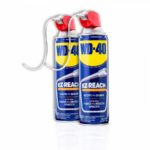Quick Navigation
If you start to experience hard times idling, especially before the car warms, it might be the time to adjust the valves on your SBC.
It is called rough idling, and it comes from the late opening of valves, which chokes off fuel. It’s common for cars to stall after a cold start.

You can adjust valves on a small block Chevy quickly and get your engine running smoothly.
In most cases, the valves are set during installation, and they will remain in place. But sometimes, they loosen up after running for a long time.
We will be teaching you how to fix this issue. You don’t have to spend money at the mechanic shop when there is an easy way.
Tools needed:
- Safety gear – goggles and gloves
- A sized spanner
Considerations
Consider several things before you start adjusting valves on a small block Chevy.
Adjusting Valves On A SBC – Hot Or Cold
You can adjust the valves on an SBC when the engine is hot or cold. It’s most recommended that you do it cold.
It ensures that you avoid erroneous adjustments on lifters since they may be “pumped up.”
If the engine is new and has not been run, ensure everything is lubricated. Unlubricated components tend to be sticky, giving you a false adjustment.
When the engine hits up, the metal will expand and change the clearance between the metal. Try doing measurements between a cold engine and the hot one.
You will realize the tolerance for the cold one may be looser.
Adjusting Valves Open Or Cold?
One of the main methods of adjusting valves on an SBC is the firing order.
You need to adjust the valves by loosening the adjusting nut when the valve begins to open on the first cylinder.
At the same time, you should be spinning the pushrod until the rocker arm lash appears.
After adjusting all the intake valves, you can work on the exhaust valves. There is a need to follow a specific order until you get every valve in the correct position.
How Can To Tell When To Adjust Valves On A Small Block Chevy
Check out these signs unless your engine is still new and has never run before.
- Pre-ignition. If you notice a pre-ignition on your engine, the valves have slid out of adjustment. That should automatically call for an SBC valve adjustment.
- Rattling noises. Those annoying rattling noises will never go unnoticed. Your valves are loose.
- Another common problem is overheating the engine, caused by tight valves.
- If your car consumes more fuel than average, it is time to change the valves. It will also kill the plug too fast as too much fuel is released. Knowing how to adjust valves on an SBC can come in handy.
There could be signs of loose or tight valves. It would be best to get them fixed before your engine gets damaged.
Adjusting Hydraulic Lifter To Get Proper Preload
Proper locating of the lifter on the lobe base is a crucial step. The valve is closed in this position, meaning no lift will be happening.
Watch the movement of the valves to discover the lifters that are appropriately positioned and then adjust them.
How To Adjust Valves On A Small Block Chevy – Step By Step Guide
The best time to adjust SBC valves is when the engine is cold. You can adjust them to hot, but a cold engine is more convenient.
You will find dozens of materials on adjusting valves on a small block Chevy. We are going to share something more straightforward.
We will try to make it as simple as possible.
- Firing order 1-8-4-3-6-5-7-2
- The distributor rotates clockwise by 90 degrees
- The valves need to go EIIEEIIE
- Using the Exhaust Opening/Intake closing method
Remove The Valve Covers
You want the valve covers off before adjusting valves on a small block Chevy. They are easy to remove.
It would help if you had the right ranch and then unlocked the nuts to reveal the cylinders. Then pick the cylinder you want to set on a preload.

Set The Engine In Position With An Eye On The Exhaust Valve
Rotate the engine with your hands in its natural direction while watching the exhaust valve on the chosen cylinder.
As the valve begins to open, stop rotating and set the intake rocker arm of the cylinder.
Why is this important? As soon as the exhaust valve starts opening, the intake lifter will be at the base circle of the lobe.
It is the perfect position for intake adjustment.
Removing Tension From The Pushrod
Remove the intake rocker arm adjuster from the way and make sure any tension on the pushrod is eliminated.
Leave it for about a minute allowing the hydraulic lifter to resume its neutral position.
When this happens, the spring in the lifter moves the pushrod seat up to touch the retaining lock. But you have to allow it.
If the lifters are new installations, they will already be in a neutral position.
Removing Clearance In The Pushrod
It’s the clearance in the pushrod that makes rattling noises. To work on this, jiggle the pushrod up and down while slowly and carefully tightening the adjustment nut.
Keep going until you hear and feel that clearance is no longer there. At this point, you have a “zero lash.”
Now rotate the adjusting nut one half to a complete turn from this point. Use the poly locks to lock the adjuster in its position.
Congratulations. You have correctly and successfully adjusted the intake.
Now time for your next step in adjusting valves on a small block Chevy.
Adjusting Exhaust
Keep turning the engine with your hand with an eye on the same intake. When it’s fully open, it begins to close.
Before it closes completely, stop and set the exhaust rocker arm on that specific cylinder.
Remember, an almost closed intake means the exhaust lifter is on the lobe’s base cycle.
Start loosening the exhaust rocker arm. Use the same procedure described above to adjust the rocker’s arm.
Do The Same For The Other Valves
Both the intake and exhaust valves on that cylinder are now well adjusted. It’s time to move to the next one, following the same procedure.
Checking The Engine
Have you installed a new cam and lifters? It happens when you notice any issues with these components and need new ones.
You will need to run a test after the procedure above.
After adjusting valves on your small-block Chevy, run the engine. It breaks the cam – and then readjusts while the engine is still running.
After the break-in, when the engine is idling, loosen the rocker till you hear a click.
Now slowly tighten it until the click stops. Then turn ¼, and tighten another ½ turn.
Move to the next lifter until all are done.
Consider using an old valve cover that you can drill in holes. You don’t want to keep squirting oil all over.
Conclusion
Adjusting valves on an SBC may seem an exhausting task. But it’s worth the time to adjust those valves to the position you want.
It starts by tightening the rocker until you get a zero lash. Then tighten it between ¼ to ½ of a turn.
That takes care of the first intake valve. Turn the engine and adjust the exhaust.
Do this for every cylinder until all the valves are adjusted.

With comprehensive experience in writing exceptional quality articles and blogs about cars and related stuff, Daniel is one of the finest bloggers and a hardcore car lover we have. He is an ASE certified technician with an across-the-board experience of 10 years in the industry. He could not help tinkering with anything he got his hands on from a young age, which led to his remarkable career in the automotive repair industry.
When he is not under any hood, you can find him on the water or in the woods to pursue his passion for hunting and fishing. He has been writing for multiple sectors and is a regular contributor to several publications.
He currently owns a Nissan 300ZX TT and a Pearl Yellow but plans to upgrade it to 550 HP. His favorites include the Koenigsegg CCX and Lamborghini Diablo 6.0 VT, but for him, the Ferrari 360 Spider is one of the sexiest cars that exists to date.
Being an avid world traveler, he has spent most of his time analyzing the automotive markets, latest technology, and local favorites to enhance his knowledge base. He is currently living in North Caroline, where it’s all about food and coffee and, of course, cars.






